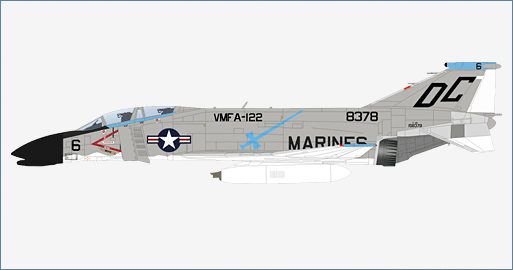Air Power Series>1:72 die-cast display model>F-4>HA19049
F-4B Phantom II 158378, VMFA-122, DA Nang Air Base, 1968 (with 3 x SUU-23 Gun Pods)

General Background
One of the most famous and easily recognized fighter aircraft of the post-WWII era was the McDonnell F-4 Phantom II. This aircraft was developed as a private venture by the aircraft company but was soon ordered by the USN as a carrier-based attack aircraft. Its first flight took place on May 27, 1958 and it entered active service in December 1960. It wasn’t long after the F-4B appeared that a fly-off was set up with USAF front-line fighters. It was no contest, the F-4 performed so well that the USAF ordered their own variant, the F-4C. As time went on, the F-4 evolved into well over a dozen variants.
Specifications :
| F4H-1 later became the F-4B | |
| Number of “B” variant built for USN and USMC: | 649 |
| Powerplant : | 2 x General Electric J79-GE-8A/-8B/-8C turbojets, 10,900 lb.s.t. dry, 17,000 lb.s.t. with afterburner |
| Performance | |
| Max Speed: | @ Sea level - 845 mph |
| @ 48,000 ft - 1,485 mph | |
| Initial climb rate: | 28,000 fpm |
| Service ceiling: | 62,000 ft |
| Combat Ceiling: | 56,850 ft |
| Combat range | |
| Normal: | 400 miles |
| Maximum range: | 2,300 miles with maximum fuel load |
| Weights | |
| Empty: | 28,000 pounds |
| Gross: | 44,600 |
| Combat: | 38,500 pounds |
| Maximum take-off: | 54,600 pounds |
| Dimensions | |
| Wingspan: | 38 ft 5 in |
| Wing area: | 530 sq. ft |
| Length: | 58 ft 3.75 in |
| Height: | 16 ft 3 in |
| Fuel | |
| Maximum fuel load: | |
| Internal in fuselage: | 1,358 U.S. Gallons |
| Internal in wings: | 630 U.S. Gallons |
| Total external fuel load: | 1,988 U.S. Gallons |
| Maximum external fuel load | |
| In center-line tank under the fuselage: | 600 U.S. Gallons |
| In 2 x under-wing tanks: | 740 U.S. Gallons |
| Combined fuel load: | 3,328 U.S. Gallons |
| Armament | 4 x AIM-7D or -7E Sparrow semi-active radar homing missiles in under-fuselage recesses |
| Inner under-wing pylons could each accommodate an additional Sparrow or a pair of AIM-9 Sidewinder infrared homing missiles | |
| In ground attack mode, could carry up to 16,000 pounds of ordnance on centerline pylon underneath the fuselage and on four under-wing hard-points |

